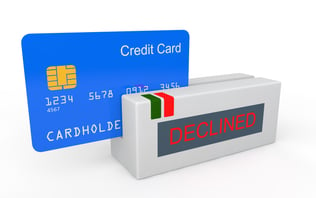
Learn what a "false decline" is, and understand how merchants can ensure a positive customer experience by avoiding them altogether.
When merchants talk about how fraud is impacting their business, they often refer to chargebacks as the primary driver of lost revenue. While the financial impact of chargeback fraud is abundantly clear, the cost of false declines often fly under the radar of most merchants.
False declines are one of the most notable and costly results of inaccurate fraud detection, and you should strive to avoid them at all costs. Not only do they have a direct impact on your revenue, but they can ruin your business's customer experience.
In this article you can expect to learn:
- How to identify a false decline
- Three tips for preventing false declines from occurring
What Exactly Are False Declines?
Due to the fact that online merchants are estimated to lose approximately $130 billion by 2023 due to fraud, there are more protections in place than ever before for online payments. Unfortunately, this also carries the possibility of false declines.
As the name suggests, a false decline is when a legitimate payment is declined due to suspected fraudulent activity. Not only are false declines detrimental to your customer experience, but they're costly. A survey by Merchant Risk Council showed that the average online store declines 2.6% of all orders because of suspected fraud. The higher the price-point of the products you're selling, the higher your decline rate will typically be.
While it's very difficult to accurately identify what percentage of declined transactions are truly fraudulent, it's estimated that false declines make up over half of all declined orders.
That's a lot of money being left on the table.
How Can You Help Prevent Them?
Although it might seem difficult to handle this problem on your own, it's doesn't have to be as complicated as your might believe. We've come up with three actionable recommendations you can follow to help prevent false declines from impacting your revenue and hurting your customer experience.
Let’s dive in.
Get in Touch With Customers Directly
If a particular order seems suspicious, it’s often better to reach out to the customer directly before immediately flagging it. Not only will this give them a chance to prove their legitimacy, but it can also help establish a long-lasting relationship with them.
More often than not, buyers will appreciate you taking the time to check on them.
Only Reject Payments Based on Data
Interestingly, many entrepreneurs tend to reject payments based on assumptions as opposed to data. For example, a merchant might decline an order that is shipped to an international address if that customer has never shipped overseas before.
Or, they might block orders to entire countries.
As you might guess, this will inevitably cause a high number of false declines and erode the relationships they could have built with those customers. Instead, you should only reject payments based on proven data.
For example, if there is a current trend of fraudulent purchases being made from a particular region in China, then it makes sense to preemptively flag orders placed from that location.
Implement Professional Fraud Prevention Software
It’s not practical to rely on manual transaction review to catch fraudulent payments. With recent advancements in machine learning technology, automated fraud detection is just as accurate (if not more accurate) than manual review. While an in-house fraud team may be able to manage your current order volume, as your business scales that team will also need to grow. With automated fraud detection, you can reduce overhead costs while simultaneously increasing your approval rates.
Fraud prevention software has been developed to help you manage this obligation. These programs are highly accurate and perform exponentially faster than a human could. They also offer end-to-end protection and are fully scalable based on your needs.
So, it’s highly recommended that you take full advantage of this resource in order to optimize both your customer experience and sales performance.
Eliminating False Declines Maximize Customer Experience
Don't underestimate the impact that false declines can have on your business. Using the aforementioned tips, you should be able to ensure that you're create an outstanding customer experience that allows you to grow your business without needing to worry about false declines.
If you're interested in learning more about Vesta's fraud prevention platform, feel free to reach out to us today so can learn more about your unique business's needs.
.png)
.png)
%20(1).png)



